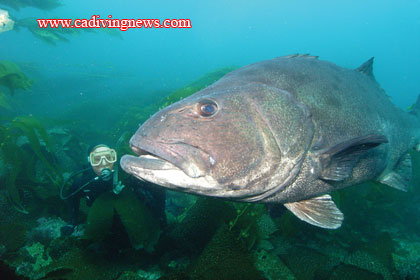Hurry and grab your cameras! They’re here! The giant black sea bass (GBSB) are back and entertaining divers once again.
Giant black sea bass (Stereolepis gigas) were once endangered and rare due to over fishing, largely blamed on excessive spearfishing and sport fishing. In 1982 they came under protection of the state government and have made a partial but dramatic comeback.
Most animals seen by divers are in the size range of 3 to 5 feet and around 300 pounds but can range upward of 7 feet long and 500 pounds. They are the largest bony fish regularly inhabiting the rock reefs of Southern California. It is their exceptionally large size and leisurely attitude that makes them excellent photo material.
FINDING THEM
By far the biggest problem in photographing these big fish is simply finding them. While they are listed as “rare” in one popular fish guide, they have been sighted on a regular basis in specific areas along the coast and the Channel Islands. Personally, I have seen Giant Black Sea Bass in the kelp forests of Point Loma and La Jolla off San Diego, on wrecks outside Los Angeles Harbor, off in the kelp forests off the Palos Verdes Peninsula, on wrecks in the Santa Monica Bay and at current-swept rocky points at Anacapa Island. But where most divers experience these gentle giants is at Catalina Island, specifically the areas of Long Point, Italian Gardens and along the east side of Goat Harbor. While it is not entirely clear as to why they congregate here, it is speculated that this is popular cleaning station or related to mating. I have always had my best luck when diving with a professional dive charter boat as they are usually plugged into “what is where” underwater at any given time and place.
YOUR APPROACH
Simple: don’t chase them. They, not you, largely dictate how the encounter will go. If they are moving away from you at even a casual pace, they will continue on their merry way. Solitary animals seem to be less conducive to an encounter but will comply on occasion. Multiple GBSB aggregation are a lot more fun. These huge fish seem to be much more relaxed and you can turn to all sorts of directions for your up close and personal visits and photos.
During your visit to the group you may be lucky enough to experience a behavior of this huge fish that is quite unique. As you approach, one or more of the fish will open its jaw and “pop” or “thud” its throat. The loud noise will reverberate through your brain and chest. It is thought that this is a notice to the group that a visitor is in its presence. If visibility is poor, listen for the thud that can indicate a giant black bass is nearby.
GETTING CLOSE
Relax. Move slowly. Approach horizontally or below. If you can get within 8 feet you can usually get within 2 feet, and here is where it gets real interesting. Take a gander of their nose and note the “whiskers” on its face. These are actually not part of the animal but rather parasites. They even invade their eyes. Watch as they move their eyes about studying you and much as you study them. You’ll also likely see scars on their bodies. Causes can only be speculated — Mating, stupid spearfishers (I’d hate to see the scars on the spearfisher!), hook and line fishers, or just scraping on the bottom to remove the parasites.
PHOTOGRAPHY
Wide-angle is a must. If you plan a trip to specifically photograph the GBSB but only have a point and shoot camera purchase a supplemental wide-angle lens.
While wide-angle is important, it is just as imperative to get as close as you can, two to three feet best depending on the capability of your lens. This technique is often referred to by pros as “close-focus wide-angle.” It will bring out the detail and character of these big animals. Get several angles of the face but try to concentrate on the leading edge, right or left. Straight on is also a lot of fun, if they will let you.
Another excellent composition technique is to include a diver or divers in your photo. This will give perspective on just how big these friendly giants are. A cooperative and smart diver can also help you to gently guide (without touching!) this fish into just the right spot. Your assisting dive buddy must also be cautious so as to not scare the animal off.
Another technique to give your photo depth is to photograph the black sea bass among the kelp stalks that it loves.
In spite of its name, black sea bass, they are actually not black but rather gray or gray with spots for younger animals. Even so, a supplemental strobe is highly desirable again to bring out the character of the fish.
And finally, keep your background a light blue (or green as the case may be) by using a horizontal or upward angle.
So grab your cameras, book your trip a trip to Catalina Island on a professional dive charter boat that knows just where the GBSB are and have fun!










